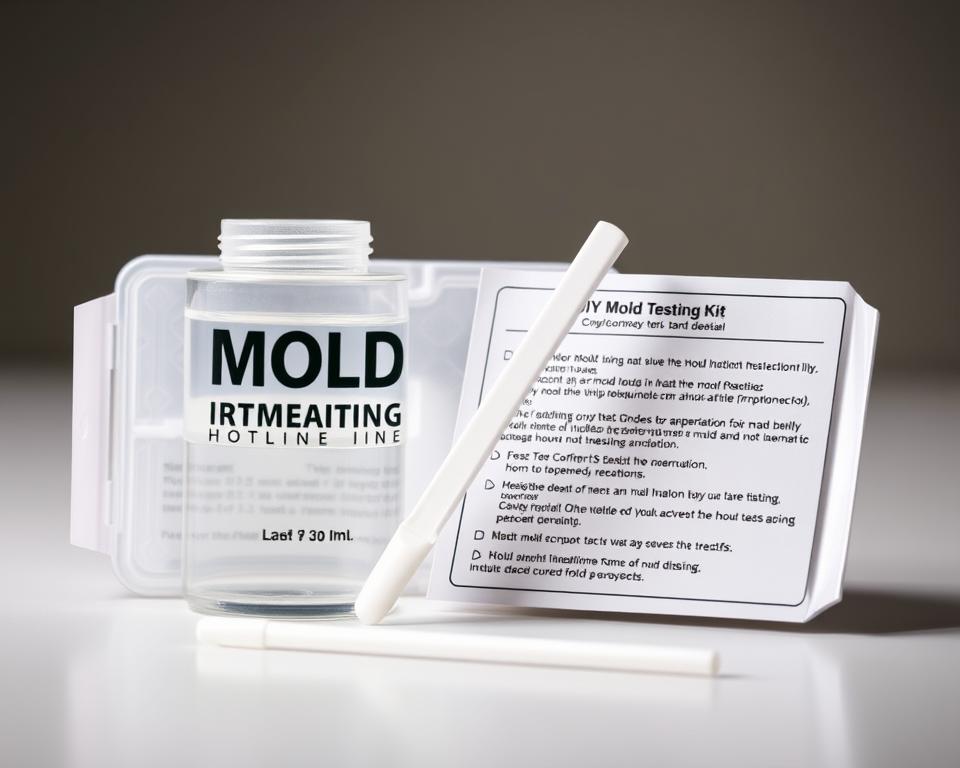Are you thinking about doing diy mold testing to make sure your home is mold-free? Do you know how to use a mold testing kit at home? Mold is normal, but it’s bad when it grows too much1. You can test for mold yourself and start making your home healthier with the right tools and knowledge.
For mold testing at home, you have a few options. You can test the air inside, the air in your HVAC system, or the surfaces2. DIY mold test kits cost about $351. This makes them a good choice for homeowners who want to save money.
Key Takeaways
- DIY mold testing is a cost-effective way to ensure your home is free from mold growth
- Mold can grow in temperatures between 40 and 100 degrees Fahrenheit1
- DIY mold test kits typically start at around $351
- There are 3 testing methods for DIY mold testing: indoor air quality test, HVAC air sampling, and surface sampling2
- Regular inspections of HVAC ductwork can prevent mold, as it can harbor mold if not properly sealed or maintained1
- Lab results are provided within 3 weeks after sending the sample for analysis2
Understanding Mold and Its Risks
Mold is a fungus that grows in homes and buildings. Russell Vent, VP of Paul Davis Restoration of Greater Rochester, NY, says people can spot mold easily. But, mold can hide, so it’s key to know how to test for it and do a thorough inspection. DIY mold test kits are helpful, but they can be wrong sometimes3.
Mold can harm health, affecting about 10% of Americans. Symptoms range from mild to severe4. Common indoor molds include Aspergillus, Penicillium, Cladosporium, and Stachybotrys chartarum (black mold). These make up over 90% of indoor mold4. Keeping your place clean and dry is vital to avoid mold risks.
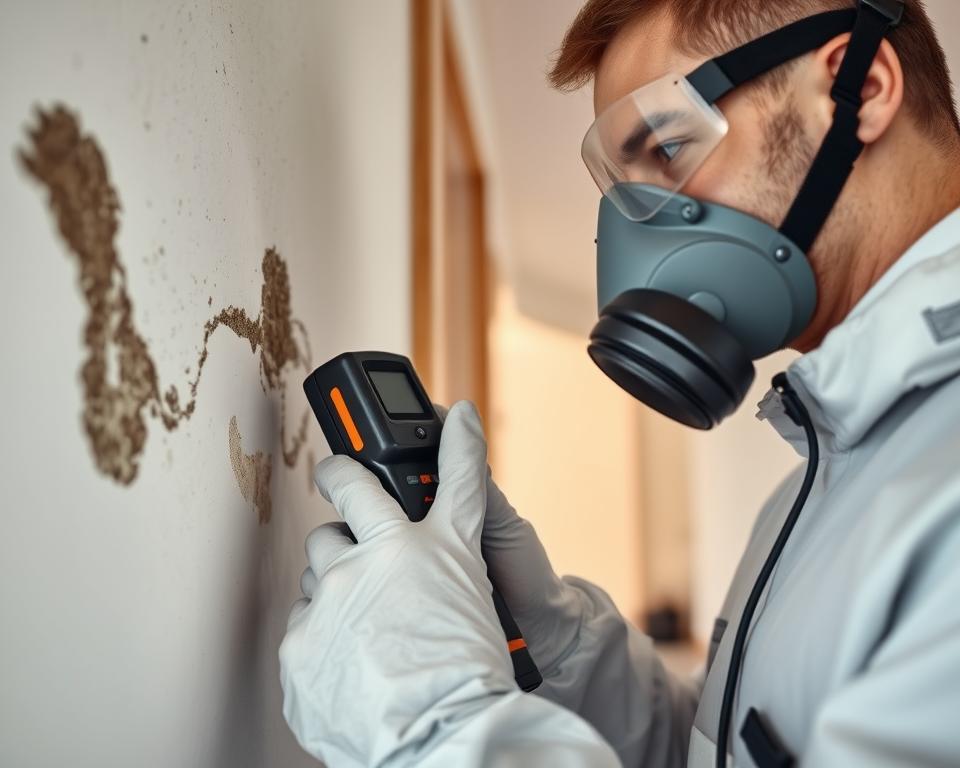
Important things to remember about mold include:
* Keeping humidity below 50% helps stop mold4
* Regular checks and upkeep can lower mold chances4
* Mold can cause health issues like breathing problems and allergies4
Knowing these and taking steps to stop mold can make your home healthier. It’s also good to know how to test for mold and do a DIY test to catch problems early.
Signs You May Need Mold Testing
Early detection of mold growth is key to avoid big damage and health risks. FAMILY HANDYMAN says plumbing leaks or water damage can cause mold. Look for signs like bubbling paint or ceiling stains5. If you see these, it’s time to think about mold testing.
Common signs for mold testing include visible mold, musty smells, and water damage. These signs mean there might be a bigger problem. Fixing them fast can stop more damage and save on mold testing costs. DIY mold testing kits are cheaper but have limits and risks.
Deciding between professional mold testing and DIY kits depends on several things. Consider the damage, health risks, and testing costs. Professional testing gives accurate results and finds the problem’s source but costs more. DIY kits are cheaper but less accurate and take more effort.
| Testing Method | Cost | Accuracy |
|---|---|---|
| Professional Mold Testing | $300-$600 | High |
| Do it Yourself Mold Testing | $35-$100 | Lower |
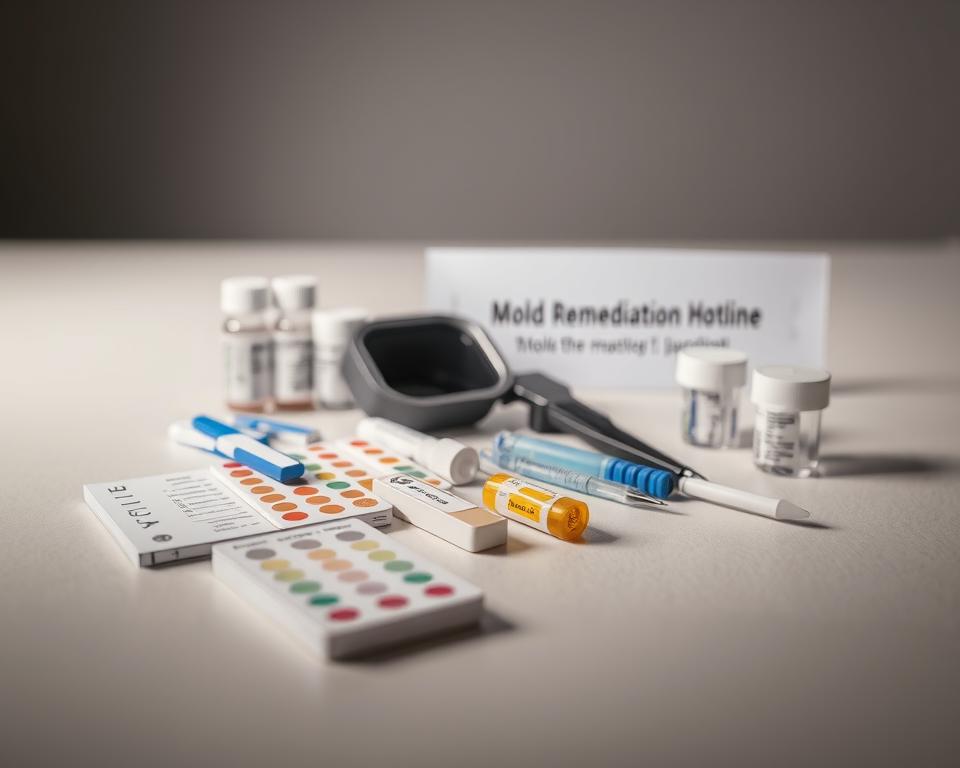
Preparing for DIY Mold Testing
Before you start testing for mold at home, you need to get ready. You’ll need some supplies and know where to test. Bethany Uribe, a building inspector, says using a moisture meter or thermal imaging is key. These tools help find areas with too much moisture, where mold likes to grow6.
Mold can grow on any moist, organic surface. It shows up as black, green, brown, or white spots6.
To get good results, follow the right steps and use the right tools. Getting ready for a mold test is important. If you don’t, you might not get accurate results7.
Here’s how to get ready for mold testing at home:
- Gather necessary supplies, including a mold testing kit
- Select testing locations, such as areas with visible mold growth or water damage
- Take safety precautions, such as wearing gloves and a mask
By following these steps and using the right tools, you can test for mold at home. Always follow the mold testing kit’s instructions. And remember to stay safe to get accurate results and a safe test6.

DIY Mold Testing Kits Overview
DIY mold testing kits are a handy way to check for mold at home. They give quick results, helping you spot mold in your house. But, picking the right kit is key. Look at its accuracy, how easy it is to use, and the price.
Using a DIY kit means taking a mold sample and sending it to a lab. Kits like the Healthful Home 5-Minute Mold Test give fast results8. But, remember, DIY kits might not always be right. They can be influenced by many things, like the mold type and how the sample is taken9.
To get good results, follow the kit’s instructions closely. Also, think about the kit’s cost and lab fees9. By picking the right kit and following the steps, you can find mold and fix it.
Conducting the Test
When you do a mold test, it’s key to follow the kit’s instructions well. Also, think about the weather, like temperature and humidity, as Erwin Miciano from Semi Homes10 says. The mold testing cost can change based on the test type and where you are. For instance, professional tests cost between $300 and $60010. DIY kits start at about $3510.
To get good results, remember these points:
- Temperature: Mold grows best between 40 and 100 degrees Fahrenheit10.
- Humidity: If the moisture meter shows over 20%, it means there’s too much humidity for mold10.
- Environmental conditions: Places with lots of moisture, like bathrooms, kitchens, and basements, are more likely to have mold11.
Choosing the right mold testing services is important. If you’re using a DIY kit, make sure to follow the directions well. Also, think about the do it yourself mold testing cost. Always do more than one test in big homes or places with past water damage to really know if there’s mold10.
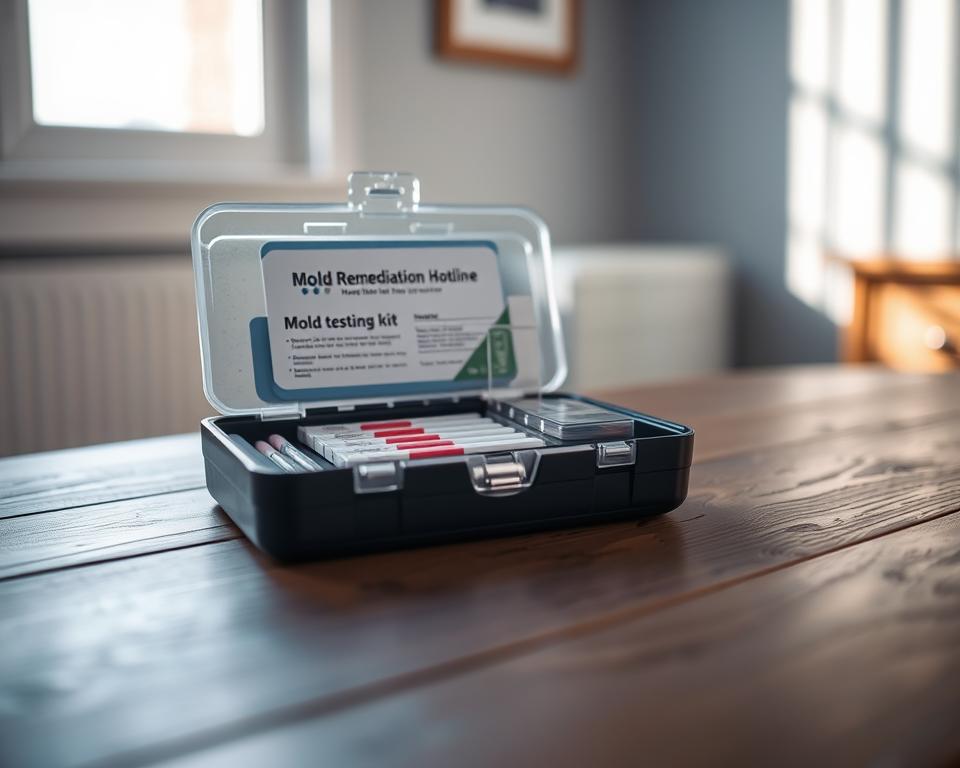
Interpreting Test Results
When you do diy mold testing, it’s key to know what the results mean. Mold Inspection Network says the lab will tell you if you have mold, what kind, and how much. They also give you a report with advice12. This info helps you decide how to fix the mold, which is important when you test at home with a mold testing kit.
Understanding mold spore count is also important. A count under 500 spores per cubic meter is normal13. But, a count over 500 sp/m³ is high13. Knowing the mold type is also key, as some, like Stachybotrys, can be very harmful13.
Some important things to remember when looking at test results are:
- Mold spore count: A count of 0-50 spores/m³ is high for some molds, like Stachybotrys and Memnoniella12.
- Mold species: Knowing the mold type is vital for fixing the problem13.
- Lab analysis: The lab report gives you advice, which is important for fixing mold12.

By understanding the test results and acting on them, you can use diy mold testing to find and fix mold at home. This makes your home safe and healthy.
Post-Testing Actions
After doing a diy mold test, it’s key to act on the results. If mold shows up, cleaning and fixing it is important. This stops it from growing more and keeps you healthy14.
Russell Vent says to watch humidity, like in basements. Also, check plumbing for leaks and use a dehumidifier to stop mold14.
A mold inspection finds where mold grows. How to test for mold can be with DIY kits or pro services15. Pro tests are right 90% of the time, while DIY kits are 50-80% accurate15.
To stop mold from coming back, fix moisture problems and keep an eye on your home11.
Here are some ways to stop mold from growing again:
- Lower humidity
- Better air flow
- Check for mold signs often
By doing these things and acting on test results, you can keep your home mold-free and safe11.
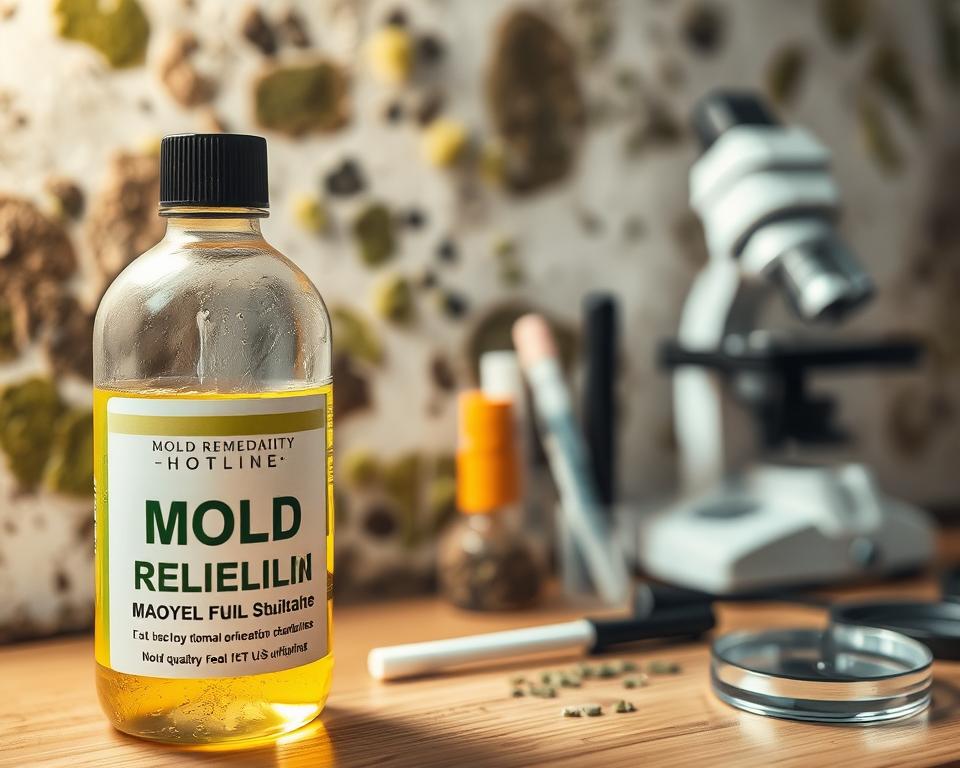
Testing for Mold in Specific Areas
It’s key to check areas that get wet often, like attics, basements, bathrooms, and kitchens16. FAMILY HANDYMAN says using a moisture meter or thermal imaging can spot wet spots16. Mold loves places where it’s really humid, over 55%16.
Look for mold signs like dark spots or color changes, often black or green16. You can buy DIY mold test kits for as little as $3516. But, for better results, getting a pro might be needed, for big problems or if you’re really worried17.
Some important places to check are:
- Attics and basements, where moisture can build up16
- Bathrooms and kitchens, where it’s usually more humid16
- HVAC systems, which can spread mold spores if not kept up17
By focusing on these spots and using the right testing, you can find and fix mold. This saves money and stops more damage16. DIY testing can save money, but remember its limits and dangers17.
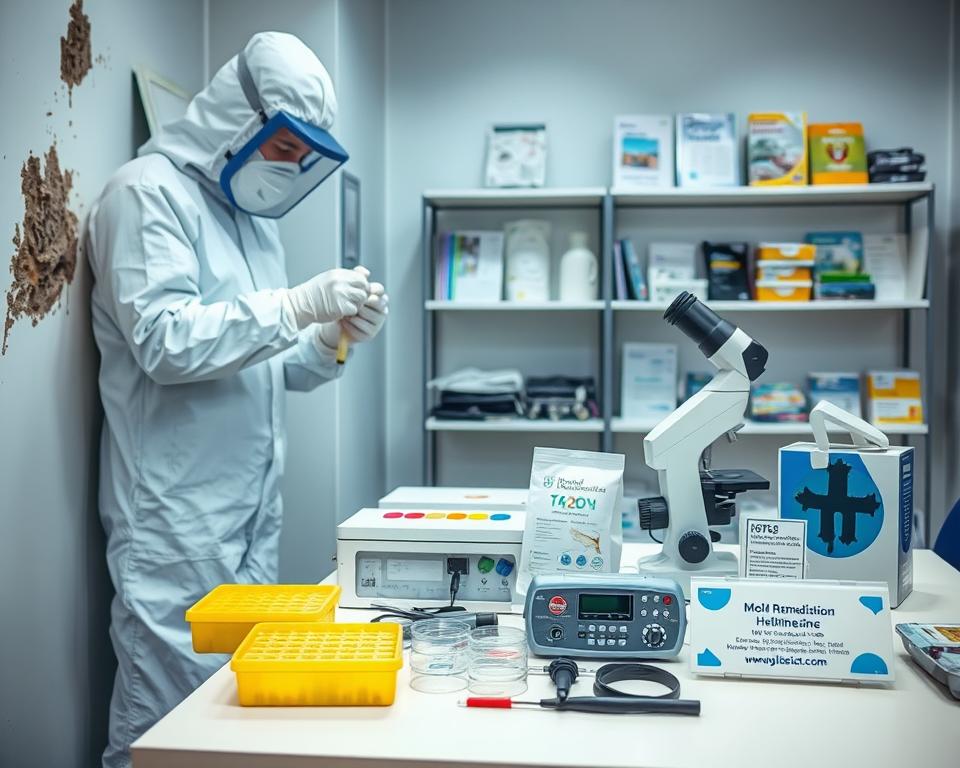
Limitations of DIY Mold Testing
DIY mold testing kits have their limits. Bethany Uribe says these kits aren’t very accurate. If you’re not sure about the results, it’s best to get a pro to test18.
Many DIY kits are not reliable. They are often called “junk science” because they don’t give good results18.
Some issues with DIY mold testing are:
- Results can be hard to understand
- It’s hard to know what kind of mold it is
- It can’t find all mold types
Professional mold testing is better. It checks your home well and uses special tools like moisture meters19. This helps find and fix mold problems better. If you think about mold testing at home or using a mold testing kit, think about the good and bad sides. Also, think about the dangers of wrong results.
| DIY Mold Testing | Professional Mold Testing |
|---|---|
| Limited scope, typically measuring only airborne mold spores | Comprehensive evaluation, including detailed examination of indoor environments |
| Potential for misinterpretation of results | Accurate diagnosis and effective remediation plan |
In short, DIY mold testing can show if there might be mold. But, it’s important to know its limits and the dangers of wrong results. If you’re not sure or want a detailed test, get a pro to do it1819.
Legal and Safety Considerations
When dealing with mold, it’s key to know the laws and insurance. Home sellers must disclose mold issues. Property owners can face big legal problems if they ignore mold20, which affects almost half of Americans21.
DIY mold kits are cheaper than hiring pros, saving up to 70%22. But, DIY kits might miss mold, leading to more problems22.
Mold can harm your health, causing breathing issues and more22. DIY kits might miss mold, leading to more problems22.
| Mold Testing Method | Cost | Effectiveness |
|---|---|---|
| DIY Mold Test Kit | Lower cost (30-70% lower than professional inspections)22 | May not provide a complete picture of mold levels or species21 |
| Professional Mold Inspection | Higher cost | Provides detailed reports and can detect hidden mold22 |
Understanding mold laws and safety is vital. It helps homeowners deal with mold right and avoid future issues.
Cost of DIY Mold Testing vs. Professional Testing
Homeowners often worry about the cost of mold testing. The mold testing cost changes a lot, depending on if you do it yourself or get a pro. The Healthful Home 5-Minute Mold Test is a cheaper option. It saves you a lot of money compared to hiring a mold inspector. Plus, you get quick results right in your home23.
Here’s a look at the costs:
- DIY mold testing kits cost between $10 to $5023.
- Professional mold testing costs range from $200 to $600 or more23.
- DIY kits give a basic idea of mold but might not be as accurate or thorough as pro tests23.
DIY testing can save you money in the long run. But, think about the value of getting a pro, mainly for big mold problems or hidden mold24. Pros can check the air for mold spores, which DIY kits can’t do well25.
| Testing Method | Cost | Accuracy |
|---|---|---|
| DIY Mold Testing | $10-$50 | Limited |
| Professional Mold Testing | $200-$600+ | High |
Frequently Asked Questions About DIY Mold Testing
Keeping your home healthy means checking for mold often26. But, many wonder how often to test for mold. Let’s clear up some common questions.
How Often Should Mold Testing Be Done?
Experts say test for mold every two years26. Or, test more often if you see too much moisture or a bad smell26. Testing often can catch problems early and stop big mold issues26.
Can I Test for Mold Without a Kit?
Yes, you can look for mold yourself. But, DIY kits are better for finding mold and what kind it is27. These kits give a better check than just looking and help you know what to do next.
What Are the Next Steps After Testing?
If your test shows mold, act fast26. You might need to clean and disinfect, fix the moisture problem, and get professional help27. Always be careful when dealing with mold.
Knowing how important mold testing is and acting right can keep your home healthy2627.
FAQ
How often should mold testing be done?
Can I test for mold without a kit?
What are the next steps after testing for mold?
How do I choose the right DIY mold testing kit?
What are the benefits of DIY mold testing?
When should I consider hiring a professional mold testing service?
Source Links
- https://www.familyhandyman.com/list/how-to-test-for-mold/?srsltid=AfmBOorEk9auG-MlPWthft6PQztDql3iWitGhMT_7OeZ_Fsf4CgHalYg
- https://www.moldarmor.com/product/mold-armor-do-it-yourself-mold-test-kit/
- https://www.indoordoctor.com/blog/10-reasons-diy-mold-test-kits-accurate-advised/
- https://www.servicemasterrestore.com/blog/mold-damage/what-is-mold-/
- https://www.gpinspect.com/article/home-mold-inspection/
- https://www.indoordoctor.com/blog/residential-mold-testing-what-every-homeowner-should-know/
- https://removethemold.com/how-to-prepare-for-a-mold-test/
- https://www.thisoldhouse.com/green-home/21471020/black-mold-test
- https://www.indoordoctor.com/blog/why-diy-mold-test-kits-are-not-accurate-a-comprehensive-guide/
- https://www.familyhandyman.com/list/how-to-test-for-mold/?srsltid=AfmBOoo4-GKEChL13Jh8t_4Adyr5gLqMgewQMXvNEoO4iECIzLGi8OAe
- https://www.contractors.com/how-to-test-for-mold/
- https://baldeagle.biz/beis-blog/2017/11/3/how-to-interpret-your-mold-air-sampling-results/
- https://greenworksllc.com/interpreting-mold-test-results/
- https://rjhomeinspection.com/how-to-test-for-mold-exposure-in-your-home/
- https://www.allnationrestoration.com/how-to-use-mold-testing-kit/
- https://www.familyhandyman.com/list/how-to-test-for-mold/?srsltid=AfmBOorpiITvlw4_mJnXErP6o-FlWNNYpouXWeiiqOGdKFkeok9X7Khw
- https://www.airpf.com/mold-testing-and-detection-how-to-test-for-mold-in-your-home/
- https://www.airoasis.com/blogs/articles/diy-mold-inspection-why-we-don-t-recommend-it?srsltid=AfmBOoqjZKX9_AzgCWEubSimnzZeIzEkyQDEYni2KkjVAhkh0CBEiE5h
- https://www.ultimatemoldcrew.ca/diy-mold-testing-kits-vs-professional-mold-inspection/
- https://www.stoppingmold.com/about-us/blog/2024/april/the-ultimate-guide-to-mold-remediation-tips-and-/
- https://www.minut.com/blog/check-property-mold-guide
- https://texinspec.com/diy-vs-professional-mold-testing-which-is-better/
- https://qci-online.com/restoration-experts/diy-vs-professional-mold-testing-which-is-better/
- https://forum.nachi.org/t/pro-lab-do-it-yourself-mold-test-kit/76967
- https://www.twinplumbing.com/best-cheapest-way-to-test-your-home-for-mold/
- https://www.insightenviro.com/the-faqs-of-indoor-air-quality-mold-testing/
- https://moldtestkc.com/frequently-asked-questions/
